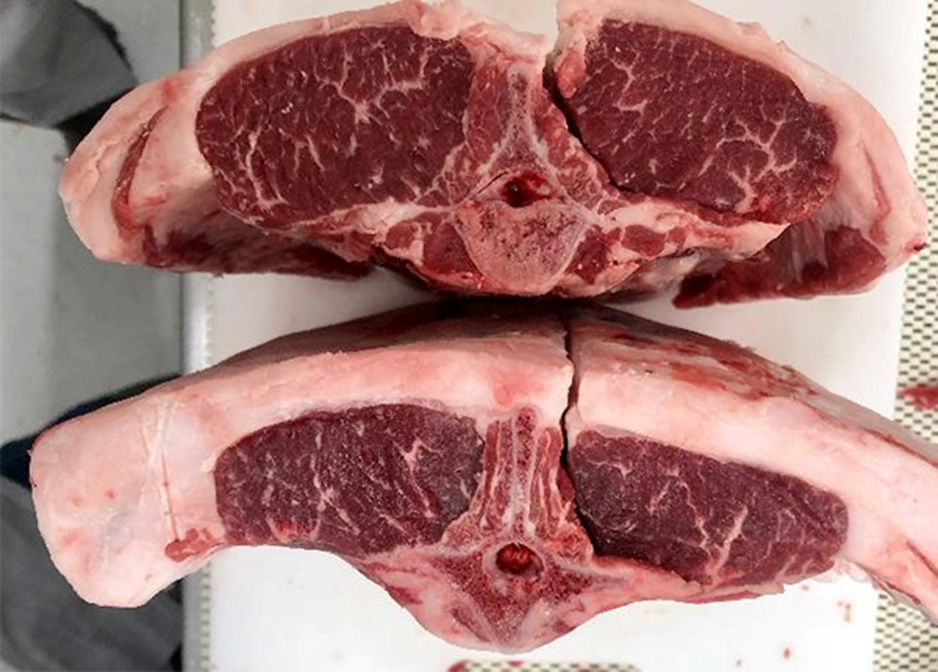Intramuscular Fat
Intramuscular fat (IMF), often known as marbling, is the distribution of fat within muscle. In lamb carcases IMF measurements are currently taken from the loin and expressed as a percentage.
Intramuscular fat is a key driver of eating quality in sheepmeat. Despite being measured in the loin, IMF has a positive impact on eating across all cuts in the carcase and contributes to all factors of eating quality, including flavour and overall liking. IMF can be influenced by genetics and management, such as nutrition leading up to slaughter. It is the last fat to be deposited in the animal, with its greatest deposition evident in later stages of the growth process when nutrition supplied to the animal is above maintenance levels. It is also the first energy source to be utilised, making nutrition leading up to slaughter very important.
Using Australian Sheep Breeding Values (ASBVs) to guide genetic decisions enables producers to move multiple traits in a desirable direction. By selecting ASBVs for eating quality and yield, it’s possible to produce lamb carcases that are higher yielding, without compromising on eating quality, over time.
The ASBVs available to use in selection for improved eating quality include Intramuscular fat (IMF) and Shearforce (SF5). ASBVs for IMF are expressed as a percentage (%), where rams with higher IMF will produce progeny with more intramuscular fat. Shearforce (SF5) is a measure of the force required to cut through the loin muscle and is therefore an indicator of tenderness. Rams with more negative SF5 ASBVs produce lambs with more tender meat.
Fat depth (FAT) is an ASBV trait that describes the fat depth, expressed in millimetres (mm).
Although both IMF and FAT measure fat deposits in the carcase, they are genetically different traits, which means only selecting for FAT will have little influence on actual IMF.
Not all fat is deposited in the same amounts or rates, so we need to utilise targeted genetic selection to get more fat to lay down within the muscle.
The most effective way to select for IMF is to avoid relying on correlated traits like FAT but rather selecting on IMF itself.
IMF has high to moderate heritability and a negative correlation with shear force, so not only does IMF increase juiciness and flavour, it also improves tenderness.
There are three terminal sire eating quality indexes available to assist balanced selection for yield and eating quality. These are ‘Eating Quality’ (EQ) and ‘Lamb Eating Quality’ (LEQ), which work to improve eating quality with modest gains in lean meat yield, while ‘Terminal Carcase Production’ (TCP) maintains eating quality with greater gains in lean meat yield.
Terminal selection indexes allow breeders and producers to increase yield while either maintaining or improving eating quality.
Align your breeding objectives with your production system and target market, and know what your limiting factor is, for example, knowing if your lamb carcases are adequately meeting fat specs for coverage.
Good nutrition and finishing are critical in defining sheepmeat eating quality in the period leading up to slaughter.
The long period of care and genetic gains can be undone in the two weeks prior to slaughter with poor nutrition and handling.
MSA recommends producers aim for post-weaning growth rates of 100-150g/head/day to optimise meat eating quality.
Animals that are losing weight will draw down on fat reserves and muscle condition for maintenance requirements, however the muscle’s connective tissue fibres will remain unchanged, leading to a potential increase in meat toughness.
It is important that sheep are kept on a rising plane of nutrition and are gaining weight before slaughter. Finishing to at least a fat score of 2 will ensure adequate fat coverage of the carcase and minimise the risk of cold-shortening and poor eating quality.

Photo: courtesy of Peter McGilchrist, UNE
In the picture above, the top loin is an example of balance between IMF and LMY In the bottom loin, although IMF is present, there is an undesirable amount (too much) of subcutaneous fat, impacting yield.
